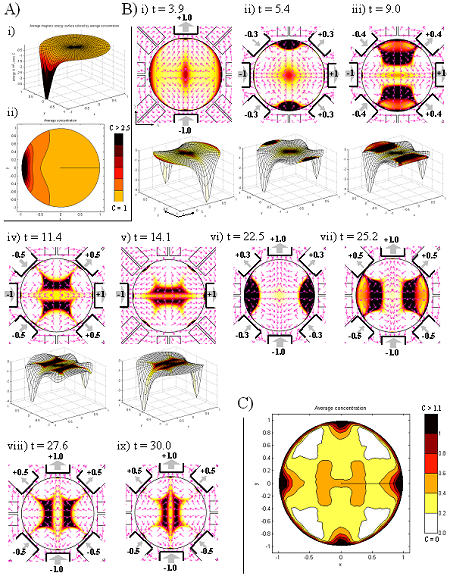a: Control of Chemotherapy to Tumors
Collaborators: Andreas Lubbe, Michael Emmert-Buck
Students: Arash Komaee, Alek Nacev, Roland Probst
The physics of magnetic particles is such that any single magnet will always attract them, regardless of its polarity (particles see forces from low to high magnetic field squared, the field is always highest near a magnet). This has meant that current magnetic drug delivery has been limited to treating shallow tumors (< 10 cm deep), and some researchers have considered implanting magnets inside patients to access deep targets (this is not desirable and is often not clinically feasible).
Our goal here is to control magnets dynamically, one against the other, to focus nano-particles between them to deep tissue targets. There are a variety of engineering tasks correlated against different clinical needs, ranging from the technologically very difficult (hit a small deep tumor exactly) to the less difficult but still extremely clinically useful (confine chemotherapy to a region to treat all tumors in it, including deep tumors, but spare healthy cells in the rest of the patients body).
Here is a first (very preliminary) result towards hitting deep targets – it shows the dynamic control of 8 magnets (in a simulation) to shape the magnetic field in space and time to direct a ferrofluid (a collection of magnetic nano-particles) to a deep center target.

A) Constant actuation: ferrofluid transport due to turning on the 5th (far left) magnet. i) The magnetic energy surface U = -k H2 is plotted along the z axis to show ferrofluid flowing downhill along the force directions F = -ÑU with the resulting averaged concentration shown by the coloring here and in sub-panel ii).
B) Dynamic control: magnets are now turned on and off to transport ferrofluid to the center. The first 5 sub-panels show ferrofluid concentration and magnetic actuation with the corresponding magnetic energy surfaces. Energy surfaces for the last 4 panels (not shown) are 90 degree flips of the ones shown (see the main text). Coloring denotes concentration (scale bar same as in C). On magnets are illustrated by heavy black lines with weighted thick gray arrows and numbering showing magnet strength and orientation (South to North outwards is a positive polarity). Thin pink arrows (normalized to unit length) show magnetic force directions which match the gradients of the magnetic energy surfaces (forces point down the surfaces).
C) The resulting time-averaged ferrofluid concentration. Note the on-average hot spot at the center target.
(This figure is taken from: B.Shapiro“Towards Dynamic Control of Magnetic Fields to Focus Magnetic Carriers to Targets Deep Inside the Body” (invited to submit from the 7th International Conference on the Scientific and Clinical Applications of Magnetic Carriers), Journal of Magnetism and Magnetic Materials, vol 321, no 10, pg 1594-1599 , 11 May 2009.)
